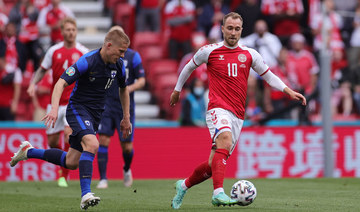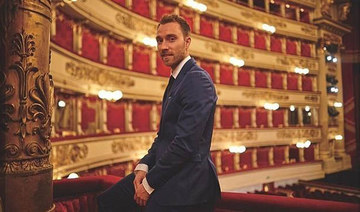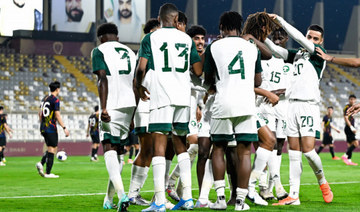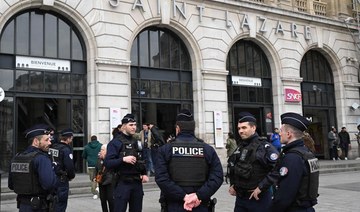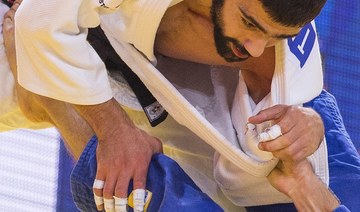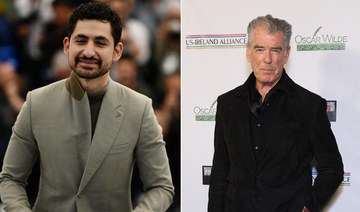COPENHAGEN, Denmark: Interest in CPR and defibrillators has been pulling the attention of Danes away from soccer’s European Championship since the collapse of Christian Eriksen.
The tournament, with the national team playing all three of its group games at home in Copenhagen, was supposed to create a two-week party in the capital — with many hoping Denmark would be able to repeat its improbable triumph from the 1992 tournament.
But Eriksen fell face-forward onto the field with cardiac arrest during the team’s opening game against Finland on Saturday. And suddenly a large portion of Denmark’s 6 million people were watching live on TV as one of the country’s best-known athletes was given emergency CPR, his teammates standing around him with tears in their eyes.
Danish Prime Minister Mette Frederiksen called it “a national shock.”
“Rarely has it been less important whether a football match was won or lost,” Frederiksen wrote on Facebook.
Eriksen, widely regarded as Denmark’s best player, was resuscitated with a defibrillator and was in a stable condition in a Copenhagen hospital on Monday.
But the national shock hasn’t quite dissipated.
Eriksen’s collapse remains the talk of the nation. Many wonder how it could happen to such a healthy player. And a debate is still raging over whether the game should have been called off. It was suspended for about 90 minutes before resuming, having been stopped near the end of the first half. Finland went on to score in the second half and won 1-0.
The interest among Danes in learning CPR and how to use a defibrillator has skyrocketed. A national organization that puts up defibrillators across the country said more than 640 people have volunteered to learn how to use one since Saturday — compared to 90 the previous weekend.
There also has been widespread anger in Denmark toward European soccer governing body UEFA for only giving the players the option of either finishing the game on Saturday evening or resuming on Sunday at noon instead.
The players themselves on Monday said they didn’t want to resume but thought it was better to finish Saturday than to come back the next day.
“It was not our wish to play,” Denmark forward Martin Braithwaite said. “We had two options and would have liked a third option. But we were told we had to make a decision. ... There were many players who weren’t in a condition to play the match. We were in a completely different place.”
Another much-debated topic has been the impact on young viewers, who watched one of their sporting idols lying unconscious on the ground.
For unprepared children, seeing such pictures equals “a slap in the face,” said Ane Lemche, a psychologist with the Danish chapter of Save the Children.
“And children can also get confused, because he looks quite lifeless and that is uncomfortable for a child,” she told Danish broadcaster DR.
Boerns Vilkaar, a child counselling organization, posted advice for parents on its website, saying many children who watched were “scared, insecure and sad.”
The Danish soccer federation also tweeted a link to the organization’s advice.
“Those kinds of pictures can be hard to get out of your head,” the organization wrote. “Some children may think about it a lot and be affected by it for a long time.”
Eriksen’s collapse creates ‘national shock’ in Denmark
https://arab.news/g32bd
Eriksen’s collapse creates ‘national shock’ in Denmark
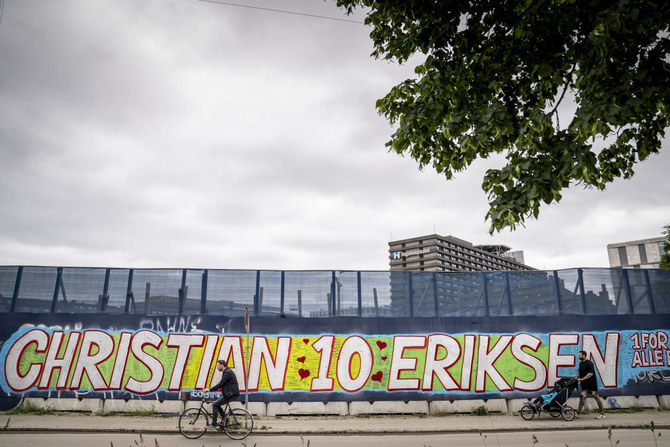
- Danish Prime Minister Mette Frederiksen: Rarely has it been less important whether a football match was won or lost
- Eriksen, widely regarded as Denmark’s best player, was resuscitated with a defibrillator and is in a stable condition in a Copenhagen hospital
Wife of British cyclist in Islamophobic social media rant

- Michelle Froome: ‘There are no innocent Gazans,’ Muslims a ‘drain on modern society’
- Husband Chris Froome rides for Israel-Premier Tech cycling team
LONDON: The wife of a former Tour de France-winning cyclist has caused controversy in the UK following an Islamophobic outburst on social media.
Michelle Froome, wife of Chris Froome, said on her X profile on Monday that there are “no innocent Gazans” and called Muslims a “drain on modern society.”
In her first posts on the platform since 2020, she told her 15,000 followers that she is “sick of sitting idly by quietly supporting Israel while the Hamas propaganda takes over social media.”
Her husband, who won four Tours de France and was an Olympian for Team GB, is a member of the Israel-Premier Tech cycling team.
While not directly affiliated with the Israeli state, it has strong ties to the country through billionaire owners Sylvan Adams and Ron Baron.
Earlier this year, the team dropped “Israel” from its vehicles for security reasons. In recent weeks, pro-Palestinian activists have called for the team to be confronted with “more protests than ever” ahead of the upcoming Giro d’Italia race in May.
In a 13-post diatribe, Michelle Froome said: “The silent majority needs to stand up and be heard. We don’t want your religion, we don’t want your beliefs. It is not compatible with modern civilisation … There are no innocent Gazans.”
She added: “Muslims are no longer the minority they claim to be. They are here to take over. The UK, France, they are happy to claim the benefits but will not integrate into those communities. They will continue to TAKE what suits them. They are a drain on modern society.
“It’s time people stop pandering to the political correctness. It’s all a facade. They burned babies alive. They deserve no remorse what so ever. This is just the beginning. WAKE UP.”
Israel’s war on Gaza recently entered its sixth month, with over 34,000 Palestinians having been killed so far.
Hosts Qatar defeat Indonesia as 2024 AFC U-23 Asian Cup begins
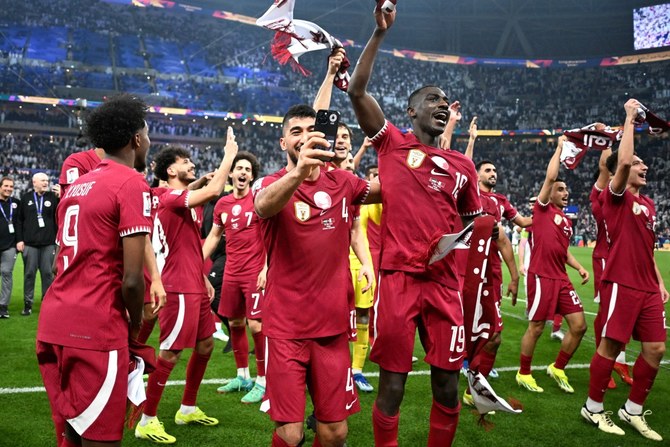
- Saudi Arabia kick off their campaign on Tuesday night, facing Tajikistan
- The tournament provides a path to the 2024 Olympic Games
DOHA: The 2024 AFC U-23 Asian Cup kicked off on Monday with hosts Qatar controversially beating nine-man Indonesia 2-0. Australia and Jordan drew 0-0 earlier in the tournament opener.
The event, which runs until May 3, also acts as a route to the men’s football competition at the 2024 Olympic Games, which take place in Paris this summer.
Qatar took the lead just before half-time at Jassim Bin Hamad Stadium, with VAR intervening to award a penalty that Tajik referee Nasrullo Kabirov had missed. Khalid Ali Sabah duly converted from the spot.
Indonesia’s task became significantly harder after the break when Ivar Jenner was sent off for a second bookable offence. Qatar doubled their lead just seven minutes later with an excellent long-range free kick from Ahmed Al-Rawi.
The visitors’ misery was complete when, deep into stoppage time, Ramadhan Sananta received a straight red card.
In the competition opener, Australia played out a stalemate with Jordan — who saw Danial Afaneh sent off after 82 minutes — at Abdullah Bin Khalifa Stadium.
The results leave Qatar at the top of Group A with three points. Australia and Jordan lie joint second with a point apiece, while Indonesia are bottom of the table on zero.
Tuesday will see Japan take on China and South Korea face the UAE in Group B, while Group C action begins with Iraq v Thailand before Saudi Arabia take on Tajikistan.
The Green Falcons will then face Thailand on April 19 and Iraq on April 22.
The 2024 AFC U-23 Asian Cup sees 16 nations split into four groups of four with the top two from each progressing to the quarterfinals.
The winners of both semifinals secure automatic qualification to the Olympic Games, regardless of which team wins the final.
The two losing semifinalists will contest third place, with the winners also booking their spot in Paris. The fourth-place finishers have one final chance by taking part in a play-off against an African qualifier.
Paris presents latest in long history of curious Olympic mascots
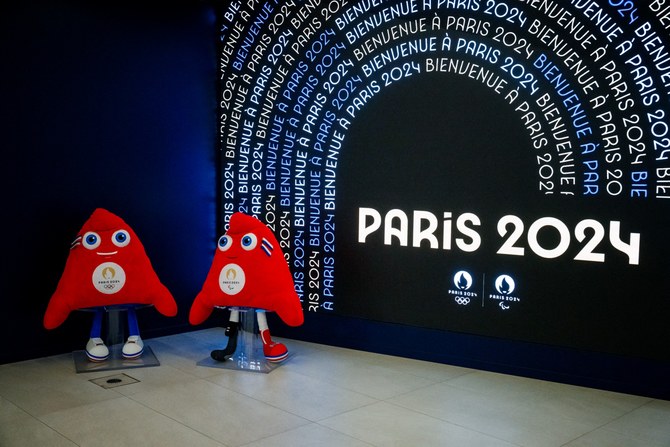
- This summer’s offering, a Phrygian cap, stands apart from the traditional animals and invented creatures of past games
On Monday, the Olympic flame was lit in Greece, and the traditional torch began its 68-stage three-month journey to Paris, where it will arrive on July 25 to signal the start the following day of the Games of the XXXIII Olympiad.
As the torch relay travels the length of France, and global interest in the Olympics grows daily over the next three months, one question above all others will be puzzling sports fans around the world.
What on earth is that peculiar mascot Paris has chosen to represent itself on the world stage?
The answer is a hat — or, more specifically, a Phrygian cap, as modelled by Marianne, symbol of the French Revolution.
Captured in oils in an 1830 painting by Eugene Delacroix, on show in the Louvre, Marianne and her hat are omnipresent in France, represented in busts and statues throughout the nation and pictured on coins and stamps.
Traditionally, Olympic mascots have either been animals or invented creatures of some sort.
But in a minor revolution of its own, 235 years after the storming of the Bastille, the Paris Olympic committee has gone in a different direction.
Instead, it has chosen to animate an object — not, as most people might have assumed, the Eiffel Tower (too predictable and, some might argue, too identifiable) but a piece of historic millinery.
Meet the “Phryges” (pronounced “freej” — the “s” is silent.)
There are two of the things, decked out in red, white and blue, with one sporting a running blade on its right leg to symbolize the Paralympics.
In the official online Olympic shop, they are available as plush toys or printed variously on backpacks, T-shirts, hoodies, mugs, tote bags, caps, water bottles, badges, lunch boxes. You can even buy an actual Phrygian cap, although regrettably only in infant size.
What has revolution got to do with the Olympics? Simple, says the committee behind the Phryges: “As Paris 2024’s vision is to demonstrate that sport can change lives, the mascots will be playing a major role by leading a revolution through sport.”
To scholars of ancient history, the hat is also a symbol of 18th-century cultural appropriation.
Although it came to symbolize the French Revolution, the Phrygian cap was worn originally in ancient Phrygia, a kingdom that thrived between 1200 and 700 BCE in the center of what is today Turkiye.
There is a funny thing about Olympic mascots. Including Paris, there have been 28 of the things since 1968, when the very first one appeared, but most people would be hard pressed to remember any of them.
It has not been for want of trying on behalf of the organizing committees — there have been some very peculiar offerings.
Take “Miraitowa,” the mascot of the 2020 Olympics in Tokyo. Remember him — or it?
A subtle blend of “traditional and futurist style,” Miraitowa embodied “both the old and the new, echoing the concept of innovation from harmony.”
One of 2,042 submitted designs, it was chosen in a poll of Japanese primary school children.
In 2014, Russia played it relatively straight and, perhaps unable to settle on a single mascot, chose three for the winter games in Sochi: a hare, a polar bear and a leopard, for no apparent reason.
It was certainly a welcome break from London’s surreal offering in 2012.
“Wenlock” was a baffling confection of obscure references — a metallic look explained by the fact that he was, supposedly, “made from one of the last drops of steel used to build the Olympic Stadium,” the light on his head reminiscent of that found on London’s famous black cabs, and the shape of his forehead “identical to that of the Olympic Stadium roof.”
His large single eye was “the lens of a camera, filming everything he sees,” while “the three points on his head represent the three places on the podium for the medal winners.”
Wenlock was an object lesson in death by committee.
And why “Wenlock”? From the town of Much Wenlock in Shropshire, of course, where the traditional Much Wenlock Games were said to have inspired Pierre de Coubertin, father of the modern Olympic movement.
In terms of obscure references, two other mascots stand out as contenders with Wenlock for a place on the podium.
In 2004 Athens offered Phevos and Athena, a brother and sister double act named for two gods of ancient Olympus but modelled on the “daidala,” a terracotta child’s toy from the 7th century BCE.
But until Paris entered the race, it was widely considered that the gold medal belonged to “Izzy,” which represented Atlanta in 1996. At the time, Izzy was unusual in being neither an animal, nor a human figure, nor an object. In fact, no-one was entirely sure what it was.
Originally named, appropriately, “Whatizit,” after a poor reception at its launch after the closing ceremony of the 1992 Games in Barcelona (which was represented by “Cobi,” a cubist vision of a Pyrenean mountain dog), Izzy underwent a radical makeover.
Alas, no-one was any wiser after Izzy’s relaunch, but it was finally put of its misery in November 2022, when the Phryges were unveiled in Paris.
As a snarky Associated Press report put it at the time, “Hey, Izzy: your 26-year reign as the worst Olympic mascot is over.”
Ironically, it is to France that the credit must go for making Olympic mascots a thing in the very first place — the first one was born in 1968, for the Winter Games in Grenoble.
It comes as little surprise to learn that “Shuss,” a cartoonish man with a large, round head, leaning forward over a pair of skis, “was created in a hurry,” according to the International Olympic Committee.
In fact, “in January 1967, his designer had only one night to prepare a plan for submission.”
While amusing, such matters might at first appear to be of little interest in a Saudi Arabia rightly focused on preparing for its 13th appearance at the summer Olympics, when it will be represented in the equestrian and taekwondo events.
But in August 2022, Prince Abdulaziz bin Turki Al-Faisal Al-Saud, Saudi Arabia’s sports minister and the Saudi Olympic and Paralympic Committee president, hinted that one day, in the not-too-distant future, the Kingdom might bid to host the Olympics.
“We’re open to discuss with the IOC about this for the future,” he said during an interview with France 24. “I think Saudi Arabia has showcased that we can host such events.”
It most certainly has, investing in, promoting and hosting global sports including football, golf, Formula One, tennis, boxing and wrestling, winning the bid to host the 22nd Asian Games and 7th Asian para games in Riyadh in 2034 and, demonstrating its ability to bring imagination to bear on the biggest stage, being chosen by the world to stage Expo 2030 in Riyadh.
When it comes to planning, investment, infrastructure and organization, in other words, the OIC is unlikely to harbor any doubts about the Kingdom’s ability to give the world one of the best Olympics it has ever seen.
But the big question is this: what would Saudi Arabia choose for its mascot?
As Olympic committees from Grenoble to Paris have demonstrated with depressing consistency, it is never too early to start thinking about this, the most important and potentially embarrassing aspect of every Olympics since 1968.
Fighters announced for upcoming 5 vs 5 Riyadh Season Original
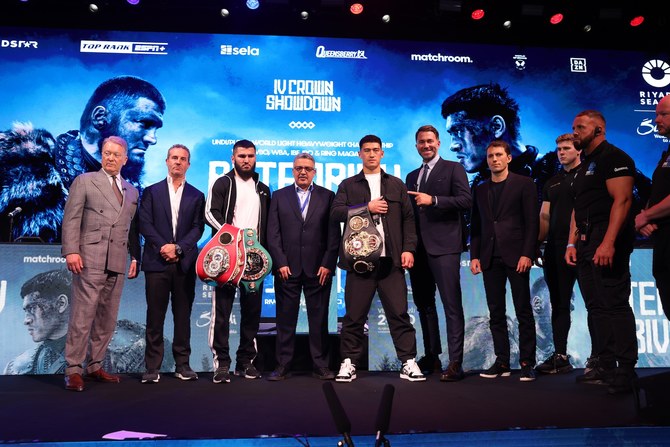
- A huge prize is on the line as the fight is recognized as a final eliminator for the WBC World Middleweight titl
RIYADH: The fighters selected to take part in the 5 vs 5 Riyadh Season Original bouts have been revealed by Saudi Arabia’s General Entertainment Authority.
Set to take place on June 1, the event will feature the “4 Crown Showdown” and is eagerly awaited by the boxing world. Going head-to-head in a bid to be crowned undisputed light heavyweight champion of the world are Artur Beterbiev and Dmitry Bivol, who will face each other in the Kingdom Arena. Both boast undefeated records as they head into the fight.
The 5 vs 5 consists of five Queensberry boxers going up against five boxers from Matchroom, giving both companies a chance to put their fighters to the test and see which of them is currently on top.
Frank Warren, Hall of Fame promoter and Queensberry chairman, said: “The night of June 1 will mark a thrilling and spectacular return to Riyadh, where the pride and reputation of two companies will be at stake in the 5 vs 5, a Riyadh Season Original concept that neither promoter dares to contemplate losing!”
And Eddie Hearn, chairman of Matchroom Sport, said: “This night is undoubtedly one of the most significant in boxing and I am grateful to His Excellency Turki Alalshikh for providing the opportunity to work in Saudi Arabia. We are talking about fights featuring some of the world’s top champions in this global and popular sport.”
Turki Alalshikh, head of the GEA, added: “Riyadh Season looks forward to hosting more major events and establishing partnerships that promise unprecedented entertainment for our audiences across the world.”
Current WBA world light heavyweight champion, 33-year-old Bivol, holds a record of 22-0, 11 Kos, and has successfully defended his title on 10 occasions over the last six years. Wrecking machine Beterbiev, 39, is the WBC, IBF and WBO world champion and has secured all 20 of his professional victories via knockout.
As well as these two renowned headliners, the other fighters taking part in the 5 vs 5 were also announced on Monday.
Heavyweight Daniel Dubois (20-2, 19 KOs) is the UK powerhouse from Queensberry who will face Matchroom’s Filip Hrgovic (17-0, 14 Kos), an IBF No. 1 contender.
Chinese giant “Big Bang” Zhilei Zhang (26-2-1, 21 KOs) will represent Queensberry in the second heavyweight encounter. The 40-year-old southpaw takes on Matchroom pick and former WBC world heavyweight champion Deontay Wilder (43-3-1, 42 KOs), the Bronze Bomber who has successfully defended the title he won back in 2015 10 times.
In what many predict will be a contender for fight of the year, Queensberry’s Nick Ball (19-0-1, 11 KOs) will square up against Matchroom’s American world champion Ray Ford, (15-0-1, 8 KOs) for the WBA World Featherweight title. This was recently won by Ford in spectacular fashion against Otabek Kholmatov via a stoppage with just seven seconds of the 12 rounds remaining.
A classic middleweight encounter is guaranteed when Queensberry’s undefeated Hamzah Sheeraz, the WBC Silver and Commonwealth champion with a record of 19-0, 15 KOs, trades blow with Matchroom’s Austin ‘Ammo’ Williams, an American who has impressively notched up a record of 16-0, 11 Kos. He also took the IBF North American title in 2023.
A huge prize is on the line as the fight is recognized as a final eliminator for the WBC World Middleweight title. Sheeraz, aged just 24, is currently on a run of 13 straight stoppages — the longest consecutive KO streak in British boxing to date.
In the final fight, Queensberry light heavyweight and former World Amateur champion Willy Hutchinson (17-1, 13 KOs), one of the brightest talents in British boxing and the current WBC International champion, will face Matchroom’s former British champion and WBA world title challenger Craig ‘Spider’ Richards (18-3-1, 11 KOs).
Francillonne, Aebersold victorious at junior fencing championships in Riyadh
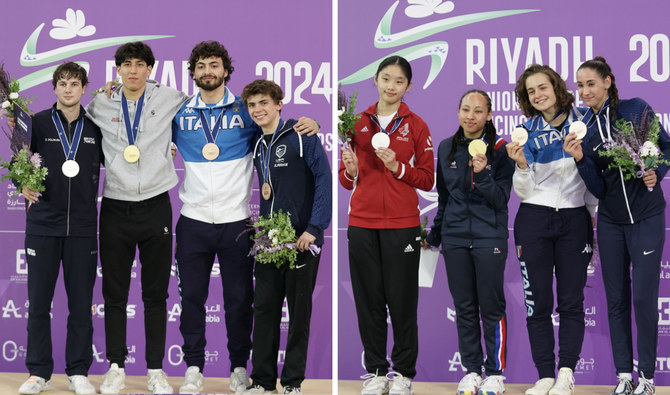
RIYADH: France’s Oceane Francillonne and Switzerland’s Alban Aebersold won gold medals in solo junior epee contests on Monday, as young fencers meet in the Saudi capital Riyadh for the Junior and Cadet Fencing World Championships.
Francillonne overcame Canada’s Julia Yin 15-12 in the final of the women’s individual epee. Francillonne defeated US’ Leehi Machulsky 15-14 in the semis.
Machulsky won the bronze, and Italian Anita Corradino received the other bronze.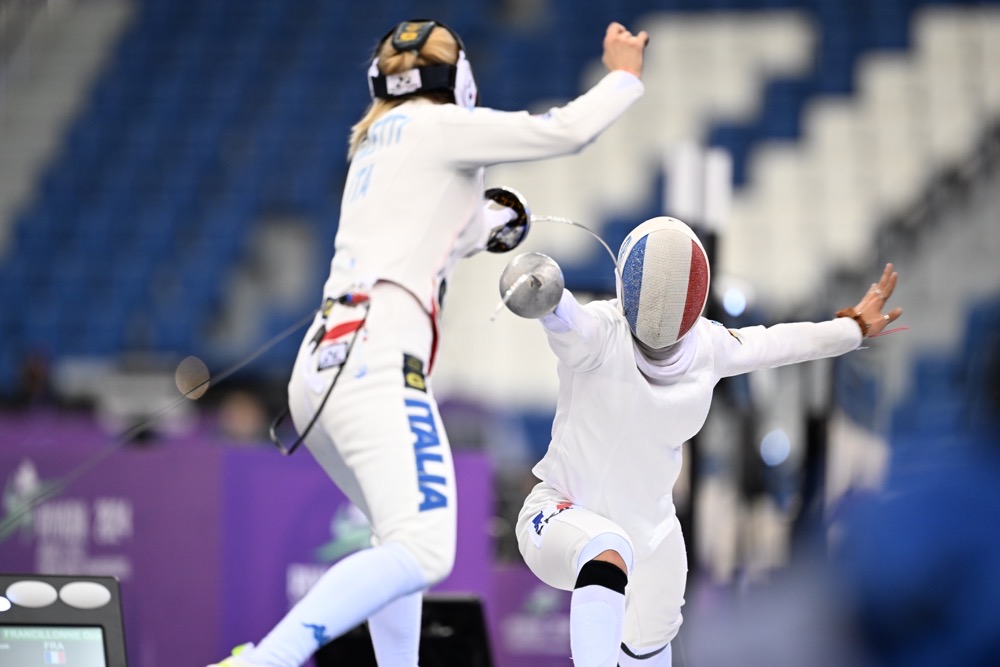
In the final of the men’s individual epee, Aebersold beat Britain’s Alec Brooke 15-13. The Swiss youngster overcame US’ Samuel Imrek 15-9 on his way to gold. Imrek and Italian Nicolo del Contrasto both claimed bronze.
President of the Saudi Fencing Federation, Ahmed Al-Sabban, and Vice President Mohammed Bou Ali, awarded the winners their medals on the fourth day of the international competition that runs until Apr. 20.
The contest, which is being held at the King Saud University Sports Arena, brings together 169 women and 214 men.
The Saudi team is being represented at the contest by Ahmed Hazazi, Youssef Al-Banali, Ali Al-Fuzai, Dania Al-Saeed, Yasmeen Al-Saleh, and Dana Al-Saeed.
On Tuesday, the youth epee competitions for men and women under 20 will be held.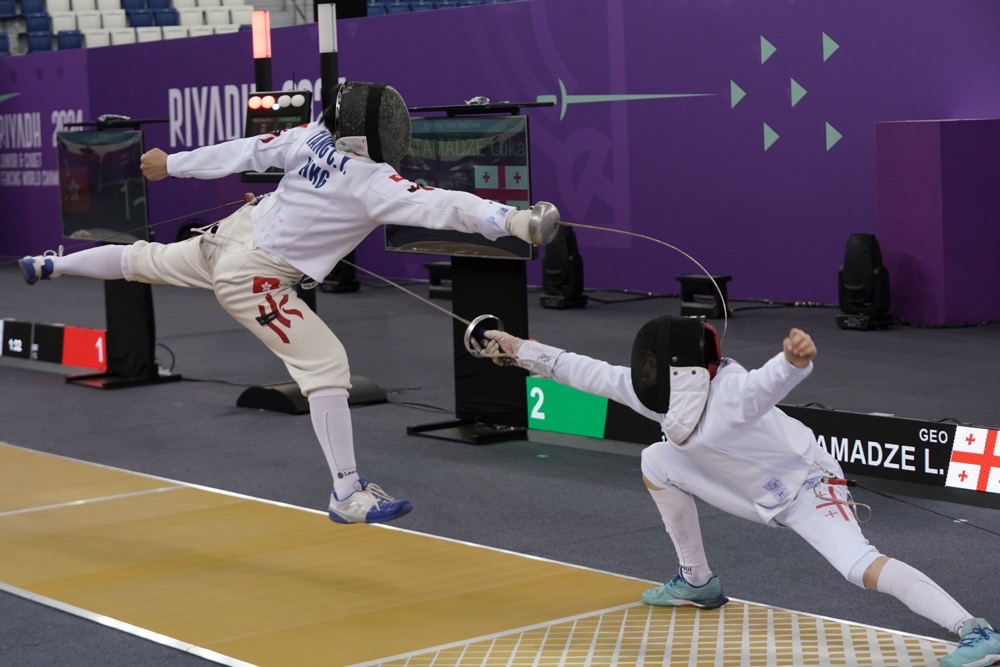
Abd Almonem Al-Husseini, the vice president of the International Fencing Federation, praised the organization of the event. He also commended the remarkable efforts of all committees and the tremendous capabilities provided by the organizing committee.
Al-Husseini predicted a rapid and significant development for Saudi fencing in the coming years.



